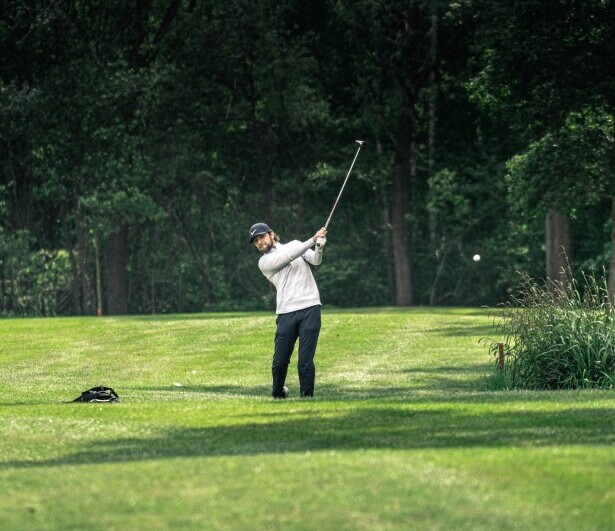Mastering Low-Punch Shots For Windy Conditions


Fore! Quick note: a few links here are affiliate links. If you snag gear through them, I earn a small commission — no extra strokes added to your game.
Punch shots. They’re not just a fancy trick for the pros. So, what exactly are they? In simple terms, a punch shot is a low-flying golf shot, designed to beat the wind and cover some solid ground while keeping low in the air. It’s kind of like driving into a headwind on the highway but keeping your hat on tight. Come along with the golf viking as we take another golf tour. Today it’s all about the punch shot.
You’ve got your regular shots, high and mighty, aiming for the stars, and then you have punch shots. These guys hug the ground more closely, favoring distance and control in tough weather conditions. Punch shots are not about showing off; they’re the practical workhorses of the golf world. A punch shot executed correctly will keep your ball from taking off in a wind or help your ball from getting stuck in a tree.
Let’s roll it back – why do they exist? Well, way back in soft-soled shoes and hickory club days, golfers faced blustery links courses. To tackle those tough conditions, they figured out a lower shot not so easily swept off course by the wind. So the punch shot was born. It’s old-school per-sistence meeting modern finesse. After all, why let some wind ruin your golf day?
Nailing this shot can seem tricky, sure, but learning it can lift your entire game. Picture hitting a low, powerful drive under a canopy of branches or holding your own breezily against a gusty fairway. It’s an art and a science—a strategic answer to unpredictable golfing moments. So why does it matter to the average golfer?
Controlling ball flight in the wind starts with strong fundamentals. Check out Mastering the Golf Swing to refine the mechanics behind a reliable punch shot.

Why Mastering Punch Shots is Essential for Golfers
Mastering punch shots isn’t just a novelty – it’s your secret weapon against Mother Nature and tricky shots. Imagine standing on the course, and the wind’s howling like a wolf. Or you’re caught behind a tree, and there’s no clear shot for miles. That’s when a slick punch shot swoops in to save the day.
So, why do you need this shot ready in your golf arsenal? It’s all about adaptability. When the sky’s flexing its windy muscles, high shots can get snagged right out of the air or pushed off course. Punch shots blend power and precision, shooting low across the fairway under the radar and keeping your ball on course amidst gusty conditions.
These shots aren’t just for bad weather, however. Picture yourself wedged between some rough stuff – like trees, bushes, or uneven patches. A high-flying shot is a no-go, but a punch shot can snake through, finding its way back to the safe spots on the green. It’s the shot for those who plan, anticipate, and play smart.
Being good at punch shots means stepping up your strategic game. It’s about more than just raw power; it’s about understanding the course, the weather, and bringing all that knowledge together as you line up for the shot. Over time, mastery here spills into every corner of your game, boosting confidence and showing your golf buddies you mean business.
Windy rounds often demand creativity in the short game. Explore Short Game Mastery for techniques that sharpen touch and consistency in challenging conditions.

Step-by-Step Mechanics of Performing a Punch Shot
Firstly, let’s get the setup right. A good stance is fundamental. Your feet should be shoulder-width apart, ensuring a stable base. This shot demands balance, Bambi on ice won’t cut it here. You need to have a solid foundation.
Next, focus on your grip. You want to choke down on the club just a tad. Think of it as getting a bit more control. The key is to feel the club’s weight, almost like you’re bringing it in for closer inspection. This helps keep your club from swinging wildly.
Now, onto posture. You want to lean a little forward, shifting your weight slightly more to your front foot. It’s all about staying grounded—don’t let the wind sway your focus. If you lean back you will end up putting your ball in the air, so keep your body posture forward.
When it comes to swinging, keep it compact. You’re not unleashing full power but crafting finesse. A shorter backswing and a firm follow-through keep the ball low and controlled. It’s like keeping the lid on a pressure cooker, letting just enough out. You’re not going for sheer distance here, you’re keeping your ball safe from drifting or obstacles.
The ball position can make a huge difference. Place it slightly back in your stance. With this, you’re encouraging that downward strike, ensuring the ball soars close to the ground, defying the wind’s bullying gusts.
Lastly, practice rhythm over speed. This shot flows; it’s not about hammering the ball. Smooth and steady wins this race. Feel it before you swing, letting the precision guide your hands and club to work in harmony. Now that we’ve gone over mechanics, let’s talk about everything it will take to execute a flawless punch shot.
Club selection makes or breaks your success in the wind. Visit Best Golf Clubs for Backspin to learn which clubs help you flight the ball lower with more control.

Tips and Techniques: Perfecting the Punch Shot
First things first, get comfortable with your equipment. If your club feels like an awkward dance partner, you’re not going to swing with confidence. Consider clubs with less loft – they naturally help keep the ball down, fitting the punch shot’s vibe. You don’t want to use a pitching wedge if you’re trying to keep your ball low.
Practice makes perfect, but smart practice seals the deal. Hit the range and focus on consistency. It’s not about how many swings you take, but the quality. Keep an eye on ball flight and adjust your stance or grip if needed. Focus on your posture and position in relation to the ball.
Once you’ve got the basics down, experiment with shot variations. Tweak your backswing, try different stances, or adjust your grip. By understanding what each change does, you’re building a toolkit for any situation on the course.
Join a class or ask someone who knows the ropes. A seasoned golfer can spot tweaks that might take you ages to notice. Plus, they might share a trick or two from their own playbook. A golf pro can tell you if you’re hitting the ball correctly.
Visualize the shot before hitting. Picture the ball flying low and straight, navigating past that tree or holding its own against a breeze. This mental prep grounds you, upping your concentration and execution. It’s always helpful to visualize and then take a few practice swings before you actually hit the ball.
Lastly, stay chill. Stress and overthinking can mess up your groove faster than a notorious wind gust. Focus on the feel of the club, the sound of the strike, and just let the ball fly. Building rhythm over force gives you more control without compromising power. Let’s wrap this up so you can get outside to work on your punch shots.
Balance is critical when hitting low shots into gusts. See Balance and Stability Drills Every Golfer Should Use for training that keeps your stance strong and steady.

Real-Life Applications: When and Where to Use Punch Shots
Picture this: you’re on a windy coastal course with gusts threatening to snag every high shot like a kite on a string. This is prime punch shot territory. Controlled, low-flying shots cut through the wind, keeping your game tight without surrendering distance.
Or maybe you’re facing an approach shot to a green that’s heavily guarded by trees or overhanging branches. Here, a punch shot becomes the path of least resistance, threading under obstacles and onto the fairway or greens safely. Hit the ball too high and you could be in a bad spot.
Another scenario is a narrow fairway layout where precision trumps power. A punch shot helps in maintaining that low trajectory, hugging the fairway while keeping your ball from drifting too far into the rough areas. It’s a game-changer for much-needed control.
When you’re stuck in the thick rough, you need to keep the ball low to escape quickly without giving up accuracy. By mastering punch shots, you sharpen your skills for such tricky spots, making recovery easier and more efficient. Punch shots give you that option to get your ball to safety without sacrificing too much distance.
Being good at punch shots also boosts your scoring strategy. Low-risk, consistent shots mean fewer mishaps and more calculated plays, ultimately enhancing your scorecard’s look. This savvy choice ensures you’re ready for whatever the course throws your way. Now that you know how to do a punch shot, you can feel good knowing that you’ll be able to get yourself out of a bad lie. I’ll see you out on the golf course, punch shot heroes.


